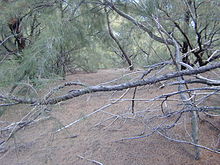
Back تضاد بيوكيميائي Arabic Allelopatiya Azerbaijani Алелопатия Bulgarian উভক্ষতি Bengali/Bangla Al·lelopatia Catalan Alelopatie Czech Allelopati Danish Allelopathie German Αλληλοπάθεια Greek Alelopatio Esperanto

Allelopathy is a biological phenomenon by which an organism produces one or more biochemicals that influence the germination, growth, survival, and reproduction of other organisms. These biochemicals are known as allelochemicals and can have beneficial (positive allelopathy) or detrimental (negative allelopathy) effects on the target organisms and the community. Allelopathy is often used narrowly to describe chemically-mediated competition between plants; however, it is sometimes defined more broadly as chemically-mediated competition between any type of organisms. The original concept developed by Hans Molisch in 1937 seemed focused only on interactions between plants, between microorganisms and between microorganisms and plants.[1] Allelochemicals are a subset of secondary metabolites,[2] which are not directly required for metabolism (i.e. growth, development and reproduction) of the allelopathic organism.
Allelopathic interactions are an important factor in determining species distribution and abundance within plant communities, and are also thought to be important in the success of many invasive plants. For specific examples, see black walnut (Juglans nigra), tree of heaven (Ailanthus altissima), black crowberry (Empetrum nigrum), spotted knapweed (Centaurea stoebe), garlic mustard (Alliaria petiolata), Casuarina/Allocasuarina spp., and nutsedge.
It can often be difficult in practice to distinguish allelopathy from resource competition. While the former is caused by the addition of a harmful chemical agent to the environment, the latter is caused by the removal of essential resources (nutrients, light, water, etc.). Often, both mechanisms can act simultaneously. Moreover, some allelochemicals may function by reducing nutrient availability. Further confounding the issue, the production of allelochemicals can itself be affected by environmental factors such as nutrient availability, temperature and pH. Today, most ecologists recognize the existence of allelopathy, however many particular cases remain controversial. Furthermore, the specific modes of action of allelochemicals on different organisms are largely open to speculation and investigation. [1]
- ^ a b Gomes, Marcelo; Garcia, Queila; Barreto, Leilane; Pimenta, Lúcia; Matheus, Miele; Figueredo, Cleber (September 2017), "Allelopathy: An overview from micro- to macroscopic organisms, from cells to environments, and the perspectives in a climate-changing world", Biologia, 72 (2): 113–129, doi:10.1515/biolog-2017-00019.
- ^ Stamp, Nancy (March 2003), "Out of the quagmire of plant defense hypotheses", The Quarterly Review of Biology, 78 (1): 23–55, doi:10.1086/367580, PMID 12661508, S2CID 10285393.